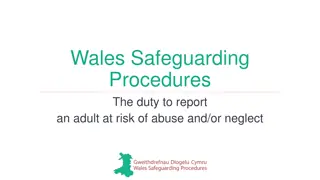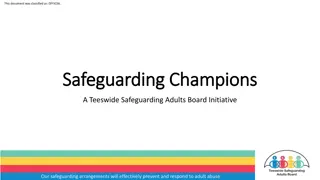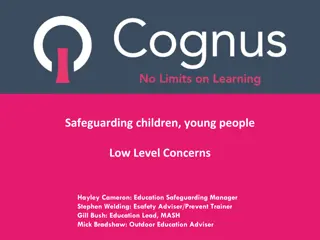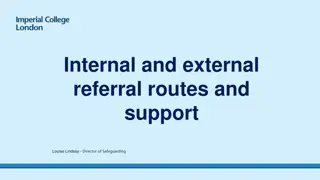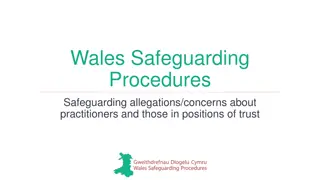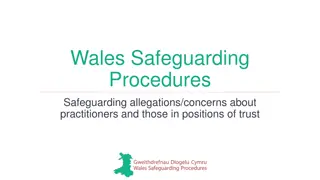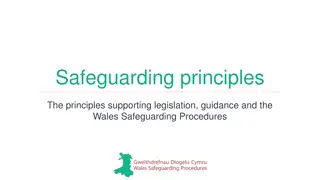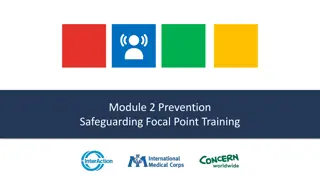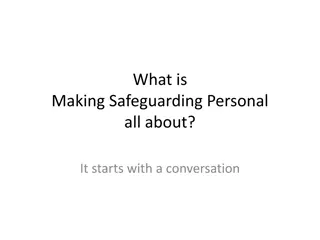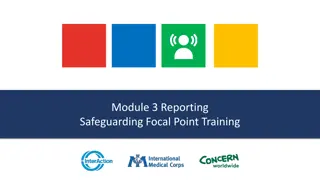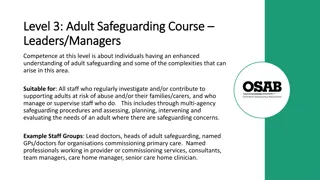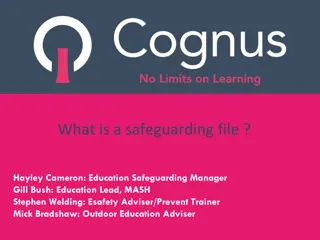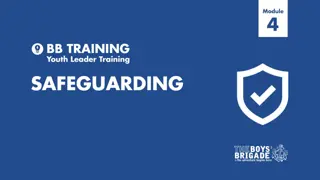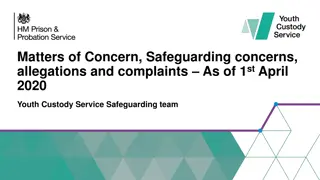Safeguarding Concerns and Reporting: Responsibilities and Procedures
Understanding the duty to report a child at risk of abuse, neglect, or harm is crucial in safeguarding practices. This report highlights the importance of documenting and discussing safeguarding concerns with the designated safeguarding person (DSP) within an organization. It emphasizes the reporting process, the role of the DSP, and when to seek advice from social services. It serves as a guide for practitioners to ensure the safety of children in vulnerable situations.
Download Presentation

Please find below an Image/Link to download the presentation.
The content on the website is provided AS IS for your information and personal use only. It may not be sold, licensed, or shared on other websites without obtaining consent from the author.If you encounter any issues during the download, it is possible that the publisher has removed the file from their server.
You are allowed to download the files provided on this website for personal or commercial use, subject to the condition that they are used lawfully. All files are the property of their respective owners.
The content on the website is provided AS IS for your information and personal use only. It may not be sold, licensed, or shared on other websites without obtaining consent from the author.
E N D
Presentation Transcript
Initial discussion to making a report The duty to report a child at risk of abuse, neglect and/ or harm
Designated safeguarding person (DSP) The person in an organisation who: is available to discuss safeguarding concerns you should consult about raising safeguarding concerns with social services will manage any immediate actions to ensure the child at risk is safe from harm All practitioners must know who to contact in their agency for advice All practitioners should not hesitate to discuss their concerns, no matter how insignificant they think they are
Reminder: You have a safeguarding concern If you re hesitant or unsure whether a child is at risk of harm, seek advice from your agency s designated safeguarding person (DSP) Contact social services directly if: contacting your DSP would cause a delay the DSP has not taken action and you re still concerned about the child the concern is about the DSP and there is no alternative
Initial discussion You have a safeguarding concern Whenever you have a safeguarding concern about a child: document your concern discussit with your agency s designated safeguarding person (DSP) Document your concern Discuss your safeguarding concern with your DSP
Initial discussion You have a safeguarding concern If you don t know whether to report concerns, contact social services for advice Document your concern seeking advice is not making a report it is the report-maker s responsibility to decide and make clear whether they wish to make a report Discuss your safeguarding concern with your DSP
Initial discussion You have a safeguarding concern Document your concern Discuss your safeguarding concern with your DSP
Discuss with DSP Discuss your safeguarding concern with your DSP The outcome of this discussion may be: No further action that no further action is needed you should include the reason for this decision when recording the discussion
Discuss with DSP Discuss your safeguarding concern with your DSP The outcome of this discussion may be: No further action the child is not at risk of harm, but your agency and/or others could meet their needs by providing early help Provide service/s you should include the reason for this decision when recording the discussion
Discuss with DSP Discuss your safeguarding concern with your DSP The outcome of this may be: the child has potential care and support needs No further action Provide service/s make a referral to social services for an assessment of potential care and support needs Referral needs assessment
Discuss with DSP Discuss your safeguarding concern with your DSP The outcome of this may be: the child is at risk of harm No further action make a report to social services about your concerns that the child is at risk of harm or has experienced harm Provide service/s Referral needs assessment Report safeguarding concern
Record your discussion Discuss your safeguarding concern with your DSP You must record in writing any discussion about the welfare of a child at risk of harm, including: No further action the date, time and names of the people included in the discussion the information you have shared and its source the reason for the decision (including no further action) what actions will be taken and by whom Provide service/s Referral needs assessment Report safeguarding concern
Reporting a concern Discuss your safeguarding concern with your DSP No further action Provide service/s Referral needs assessment Report safeguarding concern
Reporting a concern Report safeguarding concern The safety of the child at risk is always your priority If you have immediateconcerns, do not delay taking action!
Reporting a concern Report safeguarding concern Anyone, including the public, may report actual, alleged or suspected abuse or neglect directly to social services by phone, email or in writing The following procedures are when a practitioner makes a report
Gathering information Report safeguarding concern When gathering information to make a report, you should: explain your concerns and your evidence to support them provide as much specific detail and evidence as possible be honest about any factors that might influence your report documentall relevant issues about the concern establish whether any of the child/ren in the family have an early help assessment
Reporting a concern Report safeguarding concern Practitioners should use the report form of the local authority they are reporting to If you made the report by phone, you must send through the report form within 24 hours of the phone call Safeguarding report form
What to include Information about the child and their family, including names, addresses, dates of birth, contact details Details of your concerns about the risk of harm to the child Details of any plans in place to provide immediate protection Any relevant and proportionate information giving insight into the child, their family/carers and their home environment Report safeguarding concern Safeguarding report form Basic information Cause for concern Immediate protection plans Relevant, proportionate information to provide insight
Submit the report Report safeguarding concern Submit the report about your safeguarding concern without delay Safeguarding report form Basic information Cause for concern Immediate protection plans Relevant, proportionate information to provide insight Report submitted to social services
Acknowledgement Report safeguarding concern Once social services receive a written report form, they will: verify and explore the concerns discuss the situation with the police if it involves a possible criminal offence acknowledge they ve received the report within seven working days Report submitted to social services Verify and explore concerns Discuss any criminal offence with the police Acknowledge receipt within seven working days
Report follow-up Report safeguarding concern You should record: who received the report in social services what will happen next / any initial action timescales what social services will tell the child at risk and family about the report how social services can contact you for further information Report submitted to social services
Anything else? You should be prepared and willing to: Report safeguarding concern Report submitted to social services contribute to a strategy discussion/meeting assist in Section 47 enquiries attend the initial child protection conference provide a written report for the conference contribute to further assessments
What next? Report safeguarding concern It is your responsibility to ensure that your concerns are considered and acted on by the relevant agency Report submitted to social services If you are still concerned about a child, you: musttellyour line manager and your agency s DSP shouldmake another report and/or bring it to the immediate attention of the social services senior manager who has responsibility for safeguarding in your area


